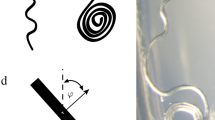Summary
-
1.
The effect of mechanical stimulation of a portion of the onion root is to reduce, or reverse the sign of, the inherent E.M.F. of the cells of the stimulated region.
-
2.
The effect upon the inherent E.M.F. of a length of root including the stimulated region is dependent upon the direction of fall of potential across the latter. Stimulation of a region whose apical end is positive in the external circuit produces a fall of total potential, while stimulation of a region whose basal end is positive produces a rise in total potential. The effect is instantaneous in all cases.
-
3.
There is no transmission of electrical effect from the stimulated region as shown by: (a) Absence of diphasic variation when stimuli are applied between the electrodes; (b) Absence of any effect when stimuli are applied outside the electrodes; (c) Adequacy of the quadrant electrometer to register the passage of impulses whose velocity does not exceed that of the slower waves recorded for Mimosa; (d) Existence of a negative condition in the stimulated cells as shown by moving the nearer electrode to include the stimulated region.
-
4.
Lund's theory of the origin of bioelectric currents is shown to offer a simple and logical explanation of the facts.
Similar content being viewed by others
Literature cited
Bishop, G. H. (1928). Galvanic stimuli to nerve. Am. Jour. Phys., Vol. 84, pp. 417–436.
Bose, J. C. (1906). Plant responsc. Longmans, Green and Co., London.
— (1910), Response in the living and non-living. Longmans, Green and Co., London.
— (1926). The nervous mechanism of plants. Longmans, Green and Co., London.
Burdon-Sanderson, J. S. (1888). On the electromotive properties of the leaf of Dionaea in the excited and unexcited states. II. Phil. Trans., Vol. 179 B, pp. 417–449.
Dixon, H. (1923). Nerves of Plants. Nature, Vol. 112, pp. 799–800.
Ebbecke, U., undHecht, G. (1923). Über elektrisch gemessene Membranänderungen an Pflanzen und die Entstehung pflanzlicher Reizbewegungen. Pflüg. Arch., Bd. 199, S. 88.
Gildemeister, M. (1915). Der sogenannte psycho-galvanische Reflex und seine physikalisch-chemische Deutung. Pflüg. Arch., Bd. 162, S. 489–506.
Hermann, L. (1880). Untersuchungen über die Aktionsströme des Nerven. II. Pflüg. Arch., Bd. 24, S. 282–294.
— (1884). Über sogenannte secundär-elektromotorische Erscheinungen an Muskeln und Nerven. Pflüg. Arch., Bd. 33, S. 161.
Kunkel, A. J. (1881). Elektrische Untersuchungen an pflanzlichen und tierischen Gebilden. Pflüg. Arch., Bd. 25, S. 342.
Lewis andRandall (1923). Thermodynamics. McGraw-Hill Book Co., New York.
Lund, E. J. (1928). II. Theory of bioelectric currents. Jour. Exp. Zool., Vol. 51, pp. 265–290.
— (1929a). Electric polarity in the Douglas Fir. Pub. Puget Sound Biol. Sta., Vol. 7, pp. 1–28.
— (1929b). The relative dominance of growing points in the Douglas Fir. Pub. Puget Sound Biol. Sta., Vol. 7, pp. 29–37.
— andKenyon, W. A. (1927). I. Electric correlation potentials in growing root tips. Jour. Exp. Zool., Vol. 48, pp. 333–357.
Marsh, G. (1928). IV. The origin of electric polarity in the onion root. Jour. Exp. Zool., Vol. 51, pp. 309–325.
McClendon, J. F., andMedes, G. (1925). Physical chemistry in biology and medicine. W. B. Saunders Co., Philadelphia and London.
Orbeli, L. A., undBrücke, E. Th. v. (1910). Die Aktionsströme der Uretermuskulatur während des Ablaufes spontaner Wellen. Pflüg. Arch., Bd. 133, S. 341–364.
Osterhout, W. J. V. (1922). Injury, recovery, and death in relation to conductivity and permeability. Lippincott, Philadelphia and London.
Stern, K (1924). Elektrophysiologie der Pflanzen. Julius Springer, Berlin.
Stiles, W. (1919). Irritability. Science Progress, Vol. XIII, p. 395.
Waller, A. D. (1897). Phil. Trans, Vol. 188B, p. 1.
Author information
Authors and Affiliations
Additional information
The writer wishes to express his gratitude to Dr. E. J.Lund for his many helpful suggestions end criticisms.
Rights and permissions
About this article
Cite this article
Marsh, G. The effect of mechanical stimulation on the inherent E.M.F. of polar tissues. Protoplasma 11, 497–520 (1930). https://doi.org/10.1007/BF01614365
Received:
Published:
Issue Date:
DOI: https://doi.org/10.1007/BF01614365




